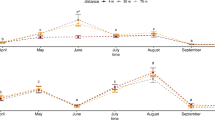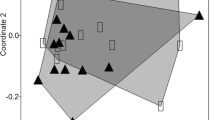Abstract
Many ant species accumulate organic debris in the vicinity of their nests. These organic materials should provide a rich resource base for the soil biota. We examined the effect of harvester ant nests (Pogonomyrmex barbatus) on the soil community and soil chemistry. Ant nest soils supported 30-fold higher densities of microarthropods and 5-fold higher densities of protozoa than surrounding, control soils. The relative abundances of the major groups of protozoa differed as well: amoebae and ciliates were relatively overrepresented, and flagellates underrepresented, in ant nest versus control soils. Densities of bacteria and fungi were similar in the two soil types. Concentrations of nitrate, ammonium, phosphorus, and potassium were significantly higher in ant nest soils, while concentrations of magnesium, calcium, and water were similar in nest and control soils. Ant nest soils were marginally more acidic than controls. The results demonstrate that P. barbatus nests constitute a significant source of spatial heterogeneity in soil biota and soil chemistry in arid grasslands.
Similar content being viewed by others
Author information
Authors and Affiliations
Additional information
Received: 17 March 1997 / Accepted: 10 June 1997
Rights and permissions
About this article
Cite this article
Wagner, D., Brown, M. & Gordon, D. Harvester ant nests, soil biota and soil chemistry. Oecologia 112, 232–236 (1997). https://doi.org/10.1007/s004420050305
Issue Date:
DOI: https://doi.org/10.1007/s004420050305




